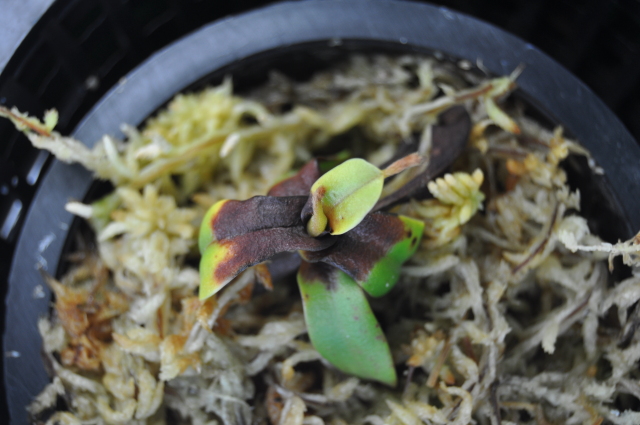Question Hamata
Hamata
QUESTION: Hey guys, Craig here from Vancouver, WA.I know you guys have had some success growing Hamatas, and I hope you can give me some pointers.
I bought a Hamata from Wistube in Octuber and does not seem to be growing well with my setup. It has grown very little since I got it and is now starting to turn brown from the center out, as seen in the pic. My setup is as follows:
Water: rain and or RO
Watering method: once a day for 20min (flood and drain on timer)
Light: 3 cfl 100w output 6500k ~ 6" away 14 hour photo-period
Soil: one part each long-fiber sphag , peat, perlite, pumice, lava rock, vermiculite, orchid bark, and charcoal. With a top layer of long fiber sphag.
Temp:Day 80-85, Night 60-65
Fans: turn on every two hours for ten min to circulate the air
Humidity: Day 75-80%, night 95%+ (using sensor and mister)
I'm thinking the day temps are too warm. What would be the ideal Hamata growing conditions?
On a side note we had a great time at the open house last summer and hope you plan on having them in the future.
Thanks for any help you can provide,
Craig
ANSWER: Hi Craig,
Hmmm... This doesn't look so good. If anything, I think your your watering schedule is a bit excessive. I prefer to keep the soil slightly damp to maintain optimal soil aeration. Daily watering for twenty minutes is excessive and would contribute to soil compaction and a quicker breakdown of the moss, peat and bark You'll need to be careful about this because if the soil loses its aeration, you can lose the plant. Sometimes you might not catch it until it's too late. This might be one of those cases.
Given your set up and humidity levels, you should water once every few days. In my greenhouse, I might water 1-2 times per week during the winter months.
So overall, I think the soil is too moist given the nature of your set up. To salvage this plant, remove the top layer of sphagnum moss and replace it with bark. Give your plant a dose of SuperThrive. Use 1 teaspoon per gallon of water. Let the solution run through, and don't water again until the soil dries slightly. Also decrease the humidity slightly, down to 50%. It's not at all necessary to keep the humidity so high. Keep in mind that high humidity often causes more problems than lower humidity.
It's tough to say if the plant will make it or not. I lost 3 hamata plants this winter, mostly because I didn't turn off my misters in time. I usually keep them on in summer and turn them off in September. I didn't turn them off until November when I saw my hamata plants exhibiting the symptoms you're now seeing. (My plants were getting misted 5 minutes every two hours.) I managed to salvage the majority of them, but lost 3 seed-grown plants, including a rare hairy hamata. That's how it goes sometimes.
So be prepared for the worse in this case. It's not an easy fix because a lot of it depends on the severity of root damage from excessive watering. So stop over watering and increase soil evaporation by decreasing the humidity. After that all you can do is wait. Within 2 weeks, you'll know if the plant will survive.
Good growing!
Jacob Farin
---------- FOLLOW-UP ----------
QUESTION: What about the temperatures?
AnswerHi Craig,
Your temperatures sound fine. This is totally within the range of what they experience in their native habitat. Like Jacob described, the problem is probably being too wet.
Good Growing!
Jeff Dallas
Sarracenia Northwest
http://www.cobraplant.com






